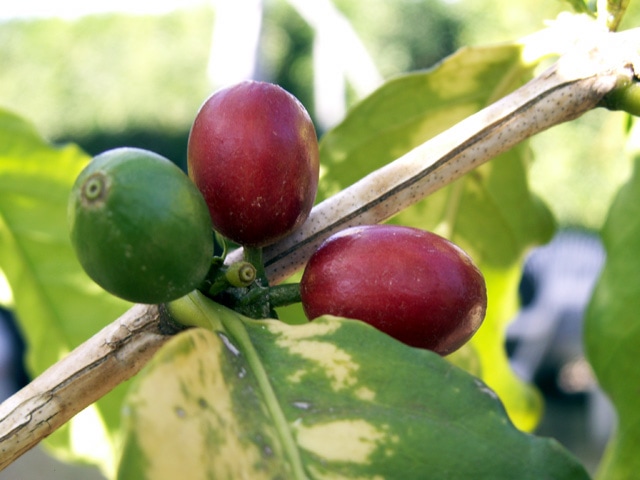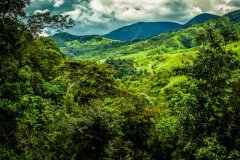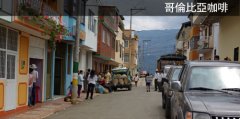Volcanic soil and family management create the reputation of jadeite coffee with both depth and depth of Colombian coffee.

For professional baristas, please follow the coffee workshop (Wechat official account cafe_style)
Volcanic soil + family management
Colombia is located in the northwest of the South American continent, bordering Central America and Panama. From the aerial view, it looks like it has been scratched by a cat on the west side, leaving three vertical paw marks from north to south. The country's famous producing areas are scattered in these fertile volcanic soil in the Andes (Cordillera).
It is said that coffee was introduced by missionaries from Venezuela in 1730 and was grown in the southeast of the country. Later, due to civil war and political reasons, it gradually moved to the western mountainous areas. In an ideal environment of high height and volcanic soil, Colombian coffee has been respected by high-end consumers in the United States and Japan since the 1940s. In addition to the inherent conditions, there is another main reason why Colombian coffee is better than Brazil: family management. They do not have heavy machinery to harvest and irrigate, nor do they have spare money to hire workers. All coffee fruits are not picked by hand until they are ripe. They cherish the piece of land they live in, from choosing fertilizer to reclamation will be enough, so there is less land fatigue. Apart from coffee, they will also grow other crops to eat or earn extra money. All these help to maintain the ecological environment.
Since 1927, Colombian farmers have organized trade unions (National Federation of Coffee Growers of Colombia) to protect each other's rights and interests. They think that "when customers can tell the difference and are willing to pay extra for it, it is boutique coffee." With a donkey dragged, a hat and a beard printed on a coffee bag from Colombia, this fictional character, a well-known fictional character in America, has been a symbol of coffee in the country since 1981. In addition, there is Parque Nacional del Caf é, an amusement park with coffee as its theme. It can be seen that Colombians are proud of producing quality coffee.
Research and development of disease-resistant soybean seeds
In terms of research, the official agency Cenicafe is responsible for the development of high-yielding and disease-resistant soybean seeds. Rust began to ravage Colombia in 1983, but before that, they had mixed common Caturra and Timor varieties with the robusta gene and developed disease-resistant Variedad Colombia from other countries. After the millennium, varieties such as Tabi (Typica, Bourbon and Timor) and Castillo (disease resistant species of Caturra) were introduced successively. Although robusta, which is often used as instant coffee, is not pure, this year's national COE competition runner-up and second runner-up coffee are mixed with Castillo varieties! It can be seen that disease resistance and taste can coexist.
As for the producing areas, famous ones include Huila, Cauca, Narino and Tolima. Among them, Huila has arranged 16 places in the top 20 places in COE this year. However, climate warming has caused temperatures in the mountains to rise, and highlands that have never been affected by the disease before are also gradually affected. Coffee farmers face not only quality, but also production capacity that affects their livelihoods.
It is often said that "high-quality South American coffee looks like Central America," meaning that Central American coffee is superior to South America, which mainly produces commercial coffee, in terms of beans, soil, and even treatment. But I think Colombia is an exception: on the cup test table, the highest-scoring boutique coffee is generally floral and fruity. The best Colombian coffee will also have a thick taste. Anyone who has experience in roasting will know that it is a mixed coffee of both shades and shades.
Patrick Tam / tr. by Phil Newell)
Important Notice :
前街咖啡 FrontStreet Coffee has moved to new addredd:
FrontStreet Coffee Address: 315,Donghua East Road,GuangZhou
Tel:020 38364473
- Prev

Emerald Coffee-basic introduction to Colombian Coffee: history of Colombian Premium Coffee
Communication of professional baristas Please pay attention to Coffee Workshop (Wechat official account cafe_style) Colombian Coffee Columbia Coffee-produced in Colombia, roasted coffee beans will release sweet aroma, with sweet in the acid, bitter in the good quality characteristics, because of the appropriate concentration, it is often used in high-grade mixed coffee. Basic introduction name of Colombian Coffee
- Next

Colombian coffee beans story Colombian coffee beans from seeds to a cup of coffee
For the exchange of professional baristas, please pay attention to the coffee workshop (Wechat official account cafe_style) basic data of the Republic of Colombia ● area of Japan 3 times the capital Bogota language Spanish per capita GDP48 ten thousand yen (4.2 million yen in Japan) 2600m above sea level the capital Bogota Colombia has a mountain area. As an equatorial country, so coffee
Related
- Detailed explanation of Jadeite planting Land in Panamanian Jadeite Manor introduction to the grading system of Jadeite competitive bidding, Red bid, Green bid and Rose Summer
- Story of Coffee planting in Brenka region of Costa Rica Stonehenge Manor anaerobic heavy honey treatment of flavor mouth
- What's on the barrel of Blue Mountain Coffee beans?
- Can American coffee also pull flowers? How to use hot American style to pull out a good-looking pattern?
- Can you make a cold extract with coffee beans? What is the right proportion for cold-extracted coffee formula?
- Indonesian PWN Gold Mandrine Coffee Origin Features Flavor How to Chong? Mandolin coffee is American.
- A brief introduction to the flavor characteristics of Brazilian yellow bourbon coffee beans
- What is the effect of different water quality on the flavor of cold-extracted coffee? What kind of water is best for brewing coffee?
- Why do you think of Rose Summer whenever you mention Panamanian coffee?
- Introduction to the characteristics of authentic blue mountain coffee bean producing areas? What is the CIB Coffee Authority in Jamaica?

